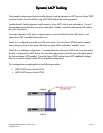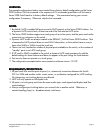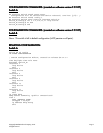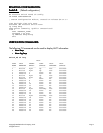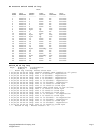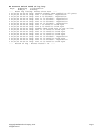WARNING:
WARNING:WARNING:
NOTES:
NOTES:NOTES:
REQUIREMENTS/RESTRICTIONS
REQUIREMENTS/RESTRICTIONSREQUIREMENTS/RESTRICTIONS
:
::
WARNING:
The example configurations below were created from a factory default configuration on the Series
2500 Switches. The first command in the sequence of CLI commands given below will first reset a
Series 2500 Switch back to its factory default settings. We recommend saving your current
configuration if necessary. Otherwise, skip the first command.
NOTES:
1. By default, LACP is enabled (all ports are set to LACP passive) on the Series 2500 Switches. For
a dynamic LACP trunk to form, at least one end of the link must be LACP active.
2. The Series 2500 Switches support one trunk group of up to four ports, and the ports need not be
consecutive or contiguous on the switch.
3. Dynamic LACP trunks are always created in the DEFAULT_VLAN of Series 2500 Switches. That
is because the LACP protocol does not send VLAN information, so the switches have no way to
know what VLAN or VLANs to put the trunk into.
4. There is no limit, besides the number of physical ports available on the switch, on the number of
"standby" ports in an LACP trunk group.
5. If STP and/or IGMP is enabled in the switch, a dynamic LACP trunk operates only with the
default settings for these features and does not appear in the port listings for these features.
6. Port security does not operate on a trunk group.
7. The configuration examples below were created on software version F.01.07.
REQUIREMENTS/RESTRICTIONS:
1. All port trunk links must be point-to-point (i.e., coterminus) connections between the Switch
2512 or 2524 and another switch, router, server, or workstation configured for LACP trunking.
No intervening, non-trunking devices are allowed.
2. LACP will only operate on full-duplex links.
3. All ports in a trunk group must have the same media type, mode (speed and duplex) and flow
control settings.
4. Always configure port trunking before you connect links to another switch. Otherwise, a
network topology loop (i.e., broadcast storm) could occur.
©Copyright Hewlett-Packard Company, 2000.
All rights reserved.
Page 2



